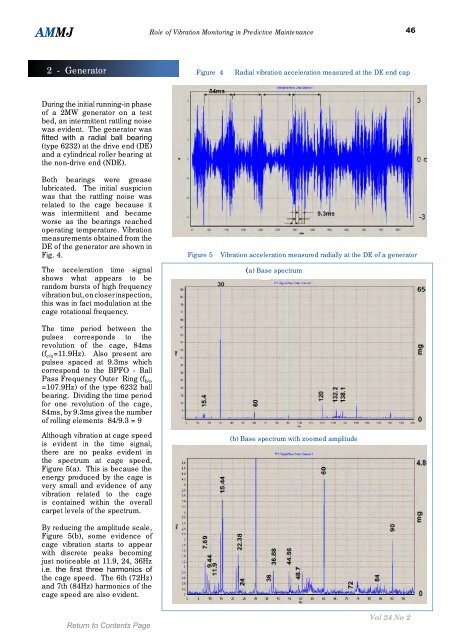April - Library
April - Library
April - Library
You also want an ePaper? Increase the reach of your titles
YUMPU automatically turns print PDFs into web optimized ePapers that Google loves.
AMMJ<br />
2 - Generator<br />
During the initial running-in phase<br />
of a 2MW generator on a test<br />
bed, an intermittent rattling noise<br />
was evident. The generator was<br />
fitted with a radial ball bearing<br />
(type 6232) at the drive end (DE)<br />
and a cylindrical roller bearing at<br />
the non-drive end (NDE).<br />
Both bearings were grease<br />
lubricated. The initial suspicion<br />
was that the rattling noise was<br />
related to the cage because it<br />
was intermittent and became<br />
worse as the bearings reached<br />
operating temperature. Vibration<br />
measurements obtained from the<br />
DE of the generator are shown in<br />
Fig. 4.<br />
The acceleration time signal<br />
shows what appears to be<br />
random bursts of high frequency<br />
vibration but, on closer inspection,<br />
this was in fact modulation at the<br />
cage rotational frequency.<br />
The time period between the<br />
pulses corresponds to the<br />
revolution of the cage, 84ms<br />
(f c/o=11.9Hz). Also present are<br />
pulses spaced at 9.3ms which<br />
correspond to the BPFO - Ball<br />
Pass Frequency Outer Ring (f b/o<br />
=107.9Hz) of the type 6232 ball<br />
bearing. Dividing the time period<br />
for one revolution of the cage,<br />
84ms, by 9.3ms gives the number<br />
of rolling elements 84/9.3 = 9<br />
Although vibration at cage speed<br />
is evident in the time signal,<br />
there are no peaks evident in<br />
the spectrum at cage speed,<br />
Figure 5(a). This is because the<br />
energy produced by the cage is<br />
very small and evidence of any<br />
vibration related to the cage<br />
is contained within the overall<br />
carpet levels of the spectrum.<br />
By reducing the amplitude scale,<br />
Figure 5(b), some evidence of<br />
cage vibration starts to appear<br />
with discrete peaks becoming<br />
just noticeable at 11.9, 24, 36Hz<br />
i.e. the first three harmonics of<br />
the cage speed. The 6th (72Hz)<br />
and 7th (84Hz) harmonics of the<br />
cage speed are also evident.<br />
Role of Vibration Monitoring in Predictive Maintenance<br />
Figure 4 Radial vibration acceleration measured at the DE end cap<br />
Figure 5 Vibration acceleration measured radially at the DE of a generator<br />
(a) Base spectrum<br />
(b) Base spectrum with zoomed amplitude<br />
46<br />
Vol 24 No 2
















